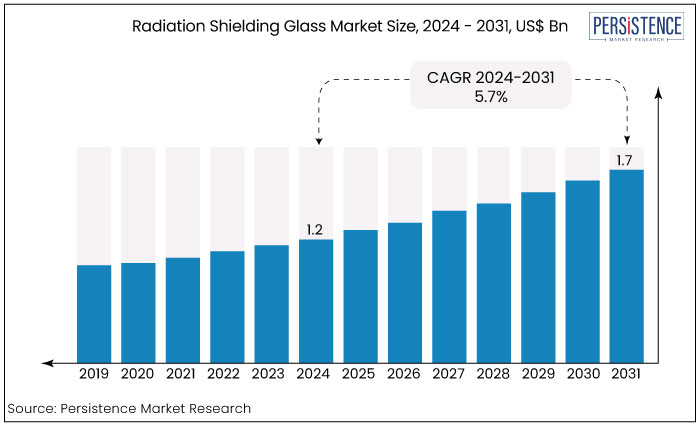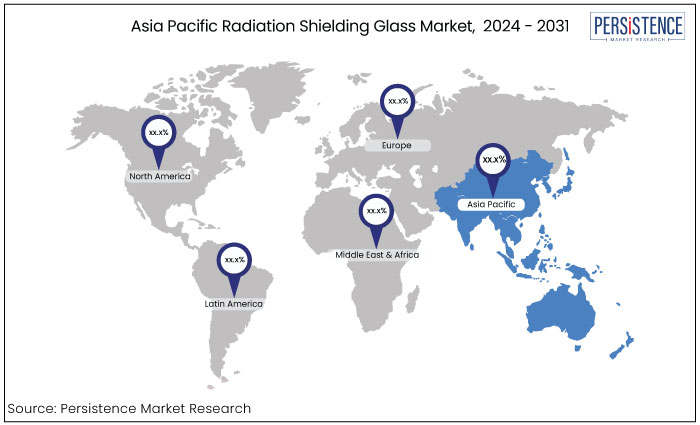Industry: Chemicals and Materials
Published Date: September-2024
Format: PPT*, PDF, EXCEL
Delivery Timelines: Contact Sales
Number of Pages: 177
Report ID: PMRREP34817
The radiation shielding glass market is estimated to increase from US$1.2 Bn in 2024 to US$1.7 Bn by 2031. The market is projected to record a CAGR of 5.7% during the forecast period from 2024 to 2031. Key drivers for market growth include diagnostic imaging, nuclear energy expansion, telemedicine, and space exploration, with the latter offering significant growth opportunities.

Key Highlights of the Market
|
Market Attributes |
Key Insights |
|
Radiation Shielding Glass Market Size (2024E) |
US$1.2 Bn |
|
Projected Market Value (2031F) |
US$1.7 Bn |
|
Global Market Growth Rate (CAGR 2024 to 2031) |
5.7% |
|
Historical Market Growth Rate (CAGR 2019 to 2023) |
4.4% |
Asia Pacific market has emerged as a significant leader primarily driven by the increasing number of radiation treatment and medical imaging centers in countries like China, India, and Japan.
As healthcare infrastructure expands to accommodate growing populations, there is a heightened demand for radiation shielding glass in radiology rooms, cancer treatment facilities, and diagnostic imaging centers.
The region's development of nuclear power plants and research centers further drives the need for effective radiation shielding materials including lead glass in control rooms and reactor containment structures.
The notable growth of manufacturing industries, such as semiconductors, aerospace, and automotive, also contributes to the rising demand for radiation shielding glass, solidifying the Asia-Pacific’s pivotal role in this market.

|
Category |
Market Share in 2024 |
|
By Radiation Type - X-Ray Shielding |
61.57% |
X-Ray shielding is expected to dominate the market capturing over 61.57% of the share. This segment emerged as the preferred choice for radiation protection demonstrating its effectiveness in mitigating X-ray exposure risks. Its critical role in industries especially within medical facilities utilizing X-ray imaging highlights the increasing adoption of these solutions.
The strong market presence of X-ray shielding glass in 2023 underscores its importance in ensuring the safety of both patients and staff during diagnostic procedures solidifying its status as a vital component in radiation safety measures.
|
Category |
Market Share in 2024 |
|
By Application- Medical |
68.71% |
The medical segment is poised to emerge as the frontrunner in the radiation shielding glass market, capturing a remarkable share of over 68.71% in 2024. This segment becomes a primary driver of demand underscoring the essential role of radiation shielding glass in safeguarding medical environments from ionizing radiation exposure. Its significant market share reflects the extensive use of this glass in healthcare facilities, especially in X-ray and computed tomography (CT) scan rooms.
The increasing need for transparent barriers that effectively shield both patients and healthcare professionals from harmful radiation has solidified the medical segment's dominance in the market.
The radiation shielding glass market overview shows lucrative opportunities for growth in the sector expecting to reach a stable CAGR in the upcoming years. Radiation shielding glass is a specialized type of glass designed to protect individuals from harmful radiation exposure, including gamma rays, X-rays, and other forms of ionizing radiation. This glass is engineered for environments where radiation is present such as hospitals, nuclear power plants, and research laboratories.
The sector has been experiencing significant growth driven by increasing awareness of radiation safety, technological advancements, and the rising number of healthcare facilities. One of the prominent radiation shielding glass market trends is the growing adoption of lead-free alternatives in radiation shielding glass as regulations around lead usage become more stringent.
Manufacturers are innovating to develop eco-friendly materials that maintain effective radiation shielding capabilities while complying with environmental standards. Moreover, the demand for customized solutions tailored to specific applications is rising with clients seeking glass products that meet unique specifications such as dimensions and radiation absorption levels.
The expansion of the medical imaging sector and ongoing research in areas like nuclear medicine and radiation therapy are further propelling the market growth. Additionally, the increasing use of radiation shielding glass in non-medical applications such as in the construction of nuclear power plants and industrial facilities highlights market's versatility and expanding scope.
The radiation shielding glass market analysis has indicated a steady growth trajectory over the past few years, with a CAGR of 4.4% from 2019 to 2023. This growth can be attributed to several factors including the increasing prevalence of medical imaging technologies, heightened awareness of radiation safety, and the expansion of nuclear facilities.
As healthcare providers and industrial sectors prioritize safety measures, the demand for effective radiation shielding solutions has surged leading to a robust market performance during this period.
The market is projected to accelerate with an anticipated CAGR of 5.7% during the period from 2024 to 2031. This upward trend is expected to be driven by several key factors. The ongoing advancements in medical imaging and radiation therapy will continue to fuel demand for high-quality shielding solutions as healthcare facilities seek to enhance patient and staff safety.
Increasing focus on environmental sustainability is prompting manufacturers to innovate lead-free and eco-friendly shielding glass alternatives aligning with global regulatory trends. The expansion of nuclear energy initiatives and the increasing need for radiation protection in various industrial applications will open several key opportunities.
Stakeholders are likely to invest in research and development to create more effective and customizable radiation shielding products as the industry evolves ensuring that the market remains responsive to the changing needs of diverse sectors.
Increasing Demand in Healthcare Sector
The healthcare sector is a key driver for radiation shielding glass market growth. With the rising prevalence of diagnostic imaging techniques such as X-rays, CT scans, and MRI, there is an escalating need for effective radiation protection solutions.
Hospitals and clinics are investing in advanced radiation shielding glass to ensure the safety of both patients and medical staff. This demand is further fueled by the growing awareness of radiation risks and the implementation of stringent safety regulations prompting healthcare facilities to prioritize protective measures in their design and operations.
Expansion of Nuclear Energy Initiatives
The global shift toward nuclear energy as a sustainable power source is another key driver for the market growth. Nuclear power is gaining traction as countries seek to reduce carbon emissions and combat climate change. This expansion necessitates the use of radiation shielding glass in various applications including reactor containment structures and control rooms to protect personnel from radiation exposure.
The increasing investment in nuclear infrastructure and the development of new facilities are expected to significantly boost the demand for high-quality radiation shielding solutions in the coming years.
Technological Advancements and Innovations
Technological advancements in materials science and manufacturing processes are driving the radiation shielding glass market expansion. Innovations such as lead-free glass alternatives and enhanced glass formulations are being developed to meet evolving safety standards and environmental regulations. These advancements improve the effectiveness of radiation shielding and cater to the growing demand for eco-friendly solutions.
As manufacturers continue to invest in research and development, the introduction of new products with superior performance characteristics is expected to drive market growth and expand application areas across various industries.
High Production Costs
One of the significant factors impeding radiation shielding glass market growth is the high production costs associated with manufacturing specialized glass. The incorporation of heavy metals such as lead or barium, which are essential for effective radiation shielding increases material costs.
The advanced manufacturing processes required to produce high-quality shielding glass can be capital-intensive. These elevated costs deter small manufacturers from entering the market and may lead to higher prices for end-users potentially limiting market expansion and adoption in various sectors.
Regulatory Challenges
Regulatory challenges also pose a significant barrier to the growth of radiation shielding glass market revenue. The stringent regulations surrounding the use of heavy metals particularly led to increased scrutiny and compliance requirements for manufacturers.
As governments worldwide implement strict environmental and health regulations, companies may face difficulties in meeting these standards while maintaining product efficacy. This can result in delays in product development and market entry as well as increased costs associated with compliance. Such challenges can hinder innovation and slow down the market growth.
Growth in Telemedicine and Remote Diagnostics
The rise of telemedicine and remote diagnostic services presents a significant opportunity for the radiation shielding glass market concentration. As healthcare providers increasingly adopt advanced imaging technologies to facilitate remote consultations, there is a growing need for effective radiation protection in home care settings and mobile diagnostic units. This trend opens avenues for the development of portable radiation shielding solutions that can be easily implemented in various environments.
Manufacturers can capitalize on this opportunity by creating innovative products tailored to meet the specific needs of telemedicine applications and ensuring patient safety in diverse settings.
Advancements in Space Exploration
The burgeoning field of space exploration offers substantial growth opportunities for the radiation shielding glass market expansion. As space agencies and private companies invest in missions beyond Earth's atmosphere, the need for effective radiation protection becomes critical due to the increased exposure to cosmic radiation. This presents an opportunity for manufacturers to develop specialized shielding glass for spacecraft, satellites, and space habitats.
Innovations in materials that provide lightweight yet effective radiation protection can enhance the safety of astronauts and equipment positioning radiation shielding glass as an essential component of future space exploration endeavors.
The radiation shielding glass market is characterized by a competitive landscape featuring key players focused on innovation and product development. For instance, Schott AG has made strides by launching its innovative X-Ray Shielding Glass in 2022 designed to provide enhanced protection with a light weight and improved optical clarity.
Key players exemplify the market's trend toward eco-friendly solutions and advanced materials positioning themselves to meet the evolving demands of various sectors reliant on radiation protection.
Recent Developments in the Radiation Shielding Glass Market
|
Attributes |
Details |
|
Forecast Period |
2024 to 2031 |
|
Historical Data Available for |
2019 to 2023 |
|
Market Analysis |
US$ Billion for Value |
|
Key Regions Covered |
|
|
Key Market Segments Covered |
|
|
Key Companies Profiled |
|
|
Report Coverage |
|
|
Customization & Pricing |
Available upon request |
By Radiation Type
By Application
By Region
To know more about delivery timeline for this report Contact Sales

The market is predicted to rise from US$1.2 Bn in 2024 to US$1.7 Bn by 2031.
SCHOTT AG, Corning Incorporated, Nippon Electric Glass Co., Ltd., Ray-Bar Engineering Corp., and Kopp Glass, Inc. are some companies in this industry.
X-ray shielding is leading segment, which is estimated to capture over 61.57% of the share in 2024.
Asia Pacific is the leading regional market for radiation shielding glass.
A promising opportunity lies in the burgeoning field of space exploration and telemedicine and remote diagnostic services.